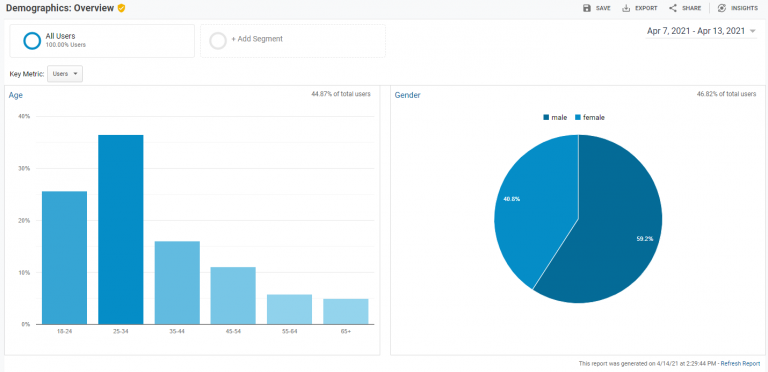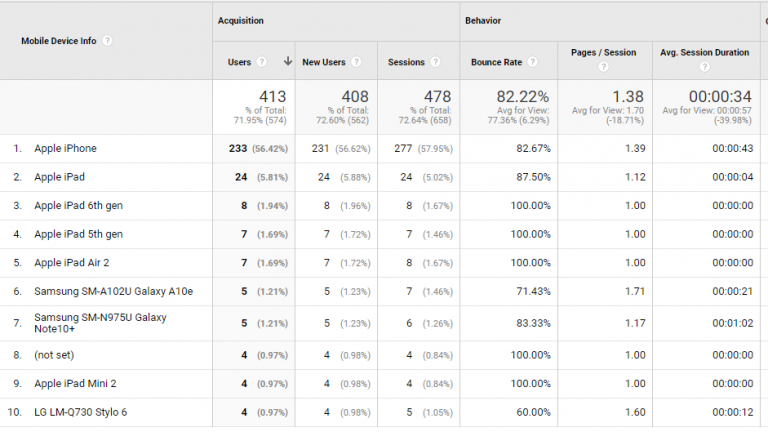A persona is a detailed profile of a fictional person that represents a person with the characteristics of your target audience.
These characteristics can include age, gender, religion, geographic location, shopping behaviors, personality traits, and more, as well as trends in online behavior.
In this column, you’ll learn how website traffic analysis can help inform your persona development efforts.
What Information Do We Need for Persona Development?
Personas are built by companies trying to better understand their current consumer base. They can inform marketing strategies and help the company best resonate with any given target audience.
Historically, personas were built by conducting research and interviews with people to gain data. However, we now have many different methods of data collection to help create a picture of this ideal audience.
There are two major ways to collect this data:
- Qualitative methods are focus group discussions, interviews, and observations of individual and group behavior. Qualitative research methods are necessary because they allow companies to understand the “why” behind consumer behavior. Hearing from real customers about why they make the purchase decisions they do gives companies valuable insight.
- Quantitative methods of research are surveys (online, paper, mobile), online polls, and longitudinal studies. Quantitative data helps to give companies more data with more definitive information than qualitative methods. It gives companies the “what, when, and how” consumers are making the purchasing decisions they do.
In recent years, website traffic analysis (particularly Google Analytics data) has become a major player in offering companies insight into their target consumers. They collect and record data on every user logging onto the website.
When you know how to find, read, and then analyze this data in terms of creating personas, you can be far more precise about who it is you are trying to reach.
Define the Type of Personas You Want to Create
Keep in mind that many companies build multiple personas but depending on the size and type of company, you may only want to create one or two.
Generally, we recommend creating one persona per brand offering.
If you are a larger company, you may want to look at your sales funnel and create personas based on that funnel.
For example, with enough data, you may notice that a certain demographic consistently drop off after your big email push while other demographics convert.
By creating two personas, you can then create two different email pushes with different marketing messages to maximize conversions.
How to Use Website Data for Persona Development
Step #1: Nail Down Basic Demographic Information
To create a persona using website data, start with the basics. The first step is to define your target consumer’s age and gender.
Using Google Analytics for your website you can navigate to this by clicking: Audience>Demographics>Overview. A list will generate the groups who visit your website the most.
If you are interested in creating more than one persona, be sure to note other higher representing groups as well.

The Geo/Language section is also a beneficial piece of data that can help to narrow down where your consumers live and what languages they speak.
You can find these filters by going to Audience>Geo>Language OR Audience>Geo>Location.
 Step #2: Look Into “Affinity Categories”
Step #2: Look Into “Affinity Categories”
The next step is to take a look at the affinity categories.
Affinity categories are created by Google Analytics as it records and analyzes a user’s browsing history, time spent on certain websites, time spent on subpages of a website, etc. and associates it to a specific interest or lifestyle of that user.
An example of an affinity category would be “Media & Entertainment/Movie Lovers.”
Learn more about how affinity categories work here.
 Step #3: Utilize the “In-Market” Section
Step #3: Utilize the “In-Market” Section
The next chunk of data to use in creating a persona is the “In Market” section in Google Analytics.
This data shows you the consumers who are actively researching products and services that are similar to your business.
While this may not jump out immediately as important for creating personas, we have found it to be incredibly helpful in offering insight into the behavior of our target user.
Find this by navigating to Audience > Interests > In-Market Segments.

You will gain a better understanding of not simply who is visiting your website and searching around, but who is actually converting.
Tip: Separate these people into their own persona as you develop remarketing and other strategies for repeat business. Keep in mind that you can use the same data to create multiple personas, meaning one “person” can help you create the persona for the top of your funnel as well as the bottom.
Step #4: Check Consumer Devices
Lastly, you can use analytics to determine what devices your consumers are using to research your business.
By seeing if they are using a desktop, mobile device, or tablet you can get a better understanding of how and when people are looking for your company and tailor your marketing strategies accordingly.
Find this data by navigating to Audience >Mobile> Devices.

Building Your Marketing Persona
Once you have recorded and digested all of the data pulled from Google Analytics you can begin to build your personas.
- Based on their age, gender, and location, give the persona a name and a face.
- Next, give them a career, socioeconomic status, and values.
- Lastly, implement their main affinity interests.
This will give a basic yet detailed persona of who you should be targeting. Example of building a persona from the following information:
- Age: 31.
- Gender: Female.
- Location: Denver, CO – English speaking.
- Career: High School Teacher.
- Salary: 55,000 a year.
- Values: Family, friends, and is budget-conscious.
- Affinity: Lifestyles and Hobbies/Green Living Enthusiast.
Persona: Sarah is very happy with her personal life and her professional life teaching high school students. The school she works at is not very environmentally conscious and she is constantly researching new products and services during her lunch break to bring to her school administration to implement for a greener school/workplace.
The Takeaway
Personas are important because they allow companies to visualize this data and use it to achieve business goals.
Personas can help to point out real buyer’s concerns, allow you to evaluate how users go through the sales journey with your business, and direct your marketing and content strategies.
In short, understand your audience, market accordingly, and watch your sales soar!
More Resources:
- 5 Ways Personas Can Improve Your Content Marketing
- 4 Ways to Enhance Your Digital Marketing via Cross-Channel Insights
- A Complete Guide to SEO: What You Need to Know
Image Credits
Featured Image: DepositPhotos.com
All screenshots taken by author, April 2021


